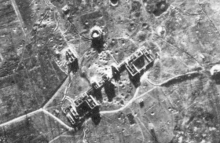First batch of NARA images released
Over 3,200 German Luftwaffe aerial photographs of places in Russia during the Second World War are now accessible online. They have been digitised courtesy of the NARA Digitisation Partnership.
These photographs are part of an enormous collection of German intelligence material found in the closing days of the war. They were discovered by American soldiers at Berchtesgaden, Hitler's mountain retreat in southern Bavaria. Code-named DICK TRACY, the collection was airlifted to the UK and combined with siezures of similar material from elsewhere. After initial analysis at the Allied Central Interpretation Unit (ACIU), at RAF Medmenham, it was shipped to the United States.
The combined collection of German aerial photography became known as the GX Library. This formed the backbone of Anglo-American target intelligence in the Cold War. The GX Library was gradually superceded by imagery from high-altitude reconnaissance planes and satellites in the 1960's.
This first tranche of images cover locations between Moscow and St Petersburg, then known as Leningrad. German forces besieged Leningrad from September 1941 to January 1944. The image featured here shows the remains of the Pulkovo Astronomical Observatory, south of the city. The observatory lay among Russian defence lines during the siege of Leningrad. Belts of trenches and anti-tank ditches are visible, encircling the ruined buildings.
All of our online images can be zoomed and panned with a website subscription.
View the first batch of NARA images.


